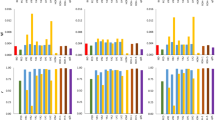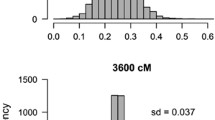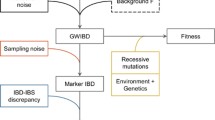Abstract
Isofemale lines are commonly used inDrosophila and other genera for the purpose of assaying genetic variation. Isofemale lines can be kept in the laboratory for many generations before genetic work is carried out, and permit the confirmation of newly discovered alleles. A problem not realized by many workers is that the commonly used estimate of allele frequency from these lines is biased. This estimation bias occurs at all times after the first laboratory generation, regardless of whether single individuals or pooled samples are used in each well of an electrophoretic gel. This bias can potentially affect the estimation of population genetic parameters, and in the case of rare allele analysis it can cause gross overestimates of gene flow. This paper provides a correction for allele frequency estimates derived from isofemale lines for any time after the lines are established in the laboratory. When pooled samples are used, this estimator performs better than the standard estimator at all times after the first generation. The estimator is also insensitive to multiple inseminations. After the lines have drifted oneN e generations, multiple inseminations actually make the new estimator perform better than it does in singly inseminated females. Simulations show that estimates made using either estimator after the lines have drifted to fixation have a much greater error associated with their use than do those estimates made earlier in time using the correction. In general it is better to use corrected estimates of gene frequency soon after lines are established than to use uncorrected estimates made after the first laboratory generation.
Similar content being viewed by others
References
Botstein, D., White, R. L., Skolnick, M., and Davis, R. W. (1980). Construction of a genetic linkage map in man using restriction fragment length polymorphism.Am. J. Hum. Genet. 32314.
Choudhary, M., and Singh, R. S. (1987). A comprehensive study of genic variation in natural populations ofDrosophila melanogaster. III. Variations in genetic structure and their causes betweenDrosophila melanogaster and its sibling speciesDrosophila simulans.Genetics 117697.
Crow, J. F., and Kimura, M. (1970).An Introduction to Population Genetics Theory Harper and Row, New York.
Falconer, D. S. (1981).Introduction to Quantitative Genetics Longman, New York.
Griffiths, R. C., McKechnie, S. W., and McKenzie, J. A. (1982). Multiple matings and sperm displacement in a natural population ofDrosophila melanogaster.Theoret. Appl. Genet. 6289.
Kojima, K., Gillespie, J., and Tobari, Y. N. (1970). A profile of Drosophila species' enzymes assayed by electrophoresis. I. Number of alleles, heterozygosities, and linkage disequilibrium in glucose-metabolizing systems and some other enzymes.Biochem. Genet. 4627.
Lewontin, R. C., and Hubby, J. L. (1966). A molecular approach to the study of genic heterozygosity in natural populations. II. Amount of variation and degree of heterozygosity in natural populations ofDrosophila pseudoobscura.Genetics 54595.
Manly, B. F. J. (1985).The Statistics of Natural Selection Edited by M. B. Usher and M. L. Rosenzweig. Population and Community Biology. Chapman and Hall, New York.
Milkman, L., and Zeitler, R. R. (1974). Cocurrent multiple paternity in natural and laboratory populations ofDrosophila melanogaster.Genetics 781191.
Nevo, E., Beiles, A., and Ben-Shlomo, R. (1984). The evolutionary significance of genetic diversity: Ecological, demographic and life history correlates. In Mani, G. S. (ed.),Evolutionary Dynamics of Genetic Diversity Springer-Verlag, Berlin, pp. 13–213.
O'Brien, S. J., and MacIntyre, R. J. (1969). An analysis of gene-enzyme variability in natural populations ofDrosophila melanogaster andD. simulans.Am. Nat. 10397.
Parsons, P. A. (1977). Isofemale strains and quantitative traits in natural populations of Drosophila.Am. Nat. 77613.
Prakash, S., Lewontin, R. C., and Hubby, J. L. (1969). A molecular approach to the study of genic heterozygosity in natural populations. IV. Patterns of genic variation in central, marginal and isolated populations ofDrosophila pseudoobscura.Genetics 61841.
Richmond, R. C. (1976). Frequency of multiple insemination in natural populations of Drosophila.Am. Nat. 117133.
Singh, R. S., and Rhomberg, L. R. (1987a). A comprehensive study of genic variation in natural populations ofDrosophila melanogaster. I. Estimates of gene flow from rare alleles.Genetics 115313.
Singh, R. S., and Rhomberg, L. R. (1987b). A comprehensive study of genic variation in natural populations ofDrosophila melanogaster. II. Estimates of heterozygosity and patterns of geographic differentiation.Genetics 117255.
Slatkin, M. (1985). Rare alleles as indicators of gene flow.Evolution 39323.
Weber, J. L., and May, P. E. (1989). Abundant class of human DNA polymorphism which can be typed using the polymerase chain reaction.Am. J. Hum. Genet. 44388.
Author information
Authors and Affiliations
Additional information
This work was supported by an NSERC fellowship to A.D.L.
Rights and permissions
About this article
Cite this article
Long, A.D. A correction for allele frequency estimates derived from isofemale lines. Biochem Genet 31, 61–74 (1993). https://doi.org/10.1007/BF02399820
Received:
Revised:
Issue Date:
DOI: https://doi.org/10.1007/BF02399820




